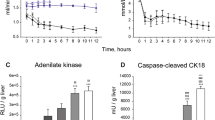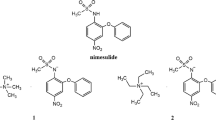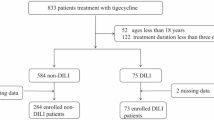Abstract
An increasing number of drugs are metabolized by aldehyde oxidase (AOX), but AOX-mediated drug interactions are seldom reported due to the lack of appropriate inhibitors and inducers. A recent study reported that nimesulide (NIM) could increase the liver injury risk of methotrexate. The latter was mainly metabolized by AOX to form hepatotoxic 7-hydroxymethotrexate (7-OH MTX). Thus, we speculated that NIM could induce AOX. In this study, we investigated the potential induction of AOX activity by NIM using methotrexate as the probe substrate. Treatment of primary human and rat hepatocytes with NIM (20 μM) for 24 h caused a 2.0- and 3.1-fold, respectively, increase in 7-OH MTX formation. Oral administration of NIM (100 mg·kg−1·d−1, for 5 days) to rats significantly increased the systematic exposure (6.5-fold), liver distribution (2.5-fold), and excretion (5.2-fold for urinary excretion and 2.1-fold for fecal excretion) of 7-OH MTX. The 7-OH MTX formation in liver cytosol from rats pretreated with 20, 50, and 100 mg·kg−1·d−1 NIM for 5 days increased by 1.9-, 3.2-, and 3.7-fold, respectively, compared with that of rats pretreated with the vehicle. We revealed that the elevation of AOX activity was accompanied by an increase in AOX1 protein levels but not the corresponding mRNA levels. Collectively, our results demonstrate for the first time that NIM can increase the AOX activity of humans and rats, and may raise concerns regarding the risk of drug interactions between NIM and AOX substrates in clinical practice.
Similar content being viewed by others
Log in or create a free account to read this content
Gain free access to this article, as well as selected content from this journal and more on nature.com
or
References
Jordan CGM, Rashidi MR, Laljee H, Clarke SE, Brown JE, Beedham C. Aldehyde oxidase‐catalysed oxidation of methotrexate in the liver of guinea‐pig, rabbit and man. J Pharm Pharmacol. 1999;51:411–8.
Behera D, Pattem R, Gudi G. Effect of commonly used organic solvents on aldehyde oxidase-mediated vanillin, phthalazine and methotrexate oxidation in human, rat and mouse liver subcellular fractions. Xenobiotica. 2014;44:722–33.
Choughule KV, Joswig-Jones CA, Jones JP. Interspecies differences in the metabolism of methotrexate: an insight into the active site differences between human and rabbit aldehyde oxidase. Biochem Pharmacol. 2015;96:288–95.
Diamond S, Boer J, Maduskuie TP Jr, Falahatpisheh N, Li Y, Yeleswaram S. Species-specific metabolism of SGX523 by aldehyde oxidase and the toxicological implications. Drug Metab Dispos. 2010;38:1277–85.
Lolkema MP, Bohets HH, Arkenau HT, Lampo A, Barale E, de Jonge MJ, et al. The c-Met tyrosine kinase inhibitor JNJ-38877605 causes renal toxicity through species-specific insoluble metabolite formation. Clin Cancer Res. 2015;21:2297–304.
Nirogi R, Kandikere V, Palacharla RC, Bhyrapuneni G, Kanamarlapudi VB, Ponnamaneni RK, et al. Identification of a suitable and selective inhibitor towards aldehyde oxidase catalyzed reactions. Xenobiotica. 2014;44:197–204.
Obach RS, Huynh P, Allen MC, Beedham C. Human liver aldehyde oxidase: inhibition by 239 drugs. J Clin Pharmacol. 2004;44:7–19.
Obach RS. Potent inhibition of human liver aldehyde oxidase by raloxifene. Drug Metab Dispos. 2004;32:89–97.
Pryde DC, Dalvie D, Hu Q, Jones P, Obach RS, Tran TD. Aldehyde oxidase: an enzyme of emerging importance in drug discovery. J Med Chem. 2010;53:8441–60.
Johnson C, Stubley-Beedham C, Stell JGP. Elevation of molybdenum hydroxylase levels in rabbit liver after ingestion of phthalazine or its hydroxylated metabolite. Biochem Pharmacol. 1984;33:3699–705.
Ohkubo M, Sakiyama S, Fujimura S. Increase of nicotinamide methyltransferase and N1-methyl-nicotinamide oxidase activities in the livers of the rats administered alkylating agents. Cancer Lett. 1983;21:175–81.
Sugihara K, Kitamura S, Yamada T, Ohta S, Yamashita K, Yasuda M, et al. Aryl hydrocarbon receptor (AhR)-mediated induction of xanthine oxidase/xanthine dehydrogenase activity by 2,3,7,8-tetrachlorodibenzo-p-dioxin. Biochem Biophys Res Commun. 2001;281:1093–9.
Rivera SP, Choi HH, Chapman B, Whitekus MJ, Terao M, Garattini E, et al. Identification of aldehyde oxidase 1 and aldehyde oxidase homologue 1 as dioxin-inducible genes. Toxicology. 2005;207:401–9.
Al-Abd AM, Inglis JJ, Nofal SM, Khalifa AE, Williams RO, El-Eraky WI, et al. Nimesulide improves the disease modifying anti-rheumatic profile of methotrexate in mice with collagen-induced arthritis. Eur J Pharmacol. 2010;644:245–50.
Langerová P, Prokeš M, Konvalinka M, Fürstová J, Urbánek K. Incidence of potential drug interactions in medication prescriptions for children and adolescents in the University Hospital Olomouc, Czech Republic. Eur J Pediatr. 2013;172:631–8.
Smeland E, Bremnes RM, Andersen A, Jaeger R, Eide TJ, Huseby NE, et al. Renal and hepatic toxicity after high-dose 7-hydroxymethotrexate in the rat. Cancer Chemother Pharmacol. 1994;34:119–24.
Smeland E, Fuskevåg OM, Nymann K, Svendsen JS, Olsen R, Lindal S, et al. High-dose 7-hydroxymethotrexate: acute toxicity and lethality in a rat model. Cancer Chemother Pharmacol. 1996;37:415–22.
Fuskevåg O-M, Kristiansen C, Lindal S, Aarbakke J. Maximum tolerated doses of methotrexate and 7-hydroxy-methotrexate in a model of acute toxicity in rats. Cancer Chemother Pharmacol. 2000;46:69–73.
Zhou L, Pang X, Jiang J, Zhong D, Chen X. Nimesulide and 4′-hydroxynimesulide as bile acid transporters inhibitors are contributory factors for drug-induced cholestasis. Drug Metab Dispos. 2017;45:441–8.
Zhou L, Pang X, Xie C, Zhong D, Chen X. Chemical and enzymatic transformations of nimesulide to GSH conjugates through reductive and oxidative mechanisms. Chem Res Toxicol. 2015;28:2267–77.
Jacobs SA, Stoller RG, Chabner BA, Johns DG. 7-Hydroxymethotrexate as a urinary metabolite in human subjects and rhesus monkeys receiving high dose methotrexate. J Clin Invest. 1976;57:534–8.
Lankelma J, van der Klein E, Ramaekers F. The role of 7-hydroxymethotrexate during methotrexate anti-cancer therapy. Cancer Lett. 1980;9:133–42.
Stiborova M, Dracinska H, Hajkova J, Kaderabkova P, Frei E, Schmeiser HH, et al. The environmental pollutant and carcinogen 3-nitrobenzanthrone and its human metabolite 3-aminobenzanthrone are potent inducers of rat hepatic cytochromes P450 1A1 and -1A2 and NAD(P)H:quinone oxidoreductase. Drug Metab Dispos. 2006;34:1398–405.
Xu Y, Li L, Wang Y, Xing J, Zhou L, Zhong D, et al. Aldehyde oxidase mediated metabolism in drug-like molecules: a combined computational and experimental study. J Med Chem. 2017;60:2973–82.
Chladek J, Martinkova J, Sispera L. An in vitro study on methotrexate hydroxylation in rat and human liver. Physiol Res. 1997;46:371–9.
Garattini E, Fratelli M, Terao M. The mammalian aldehyde oxidase gene family. Hum Genomics. 2009;4:119–30.
Ogiso T, Fukami T, Mishiro K, Konishi K, Jones JP, Nakajima M. Substrate selectivity of human aldehyde oxidase 1 in reduction of nitroaromatic drugs. Arch Biochem Biophys. 2018;659:85–92.
Paragas EM, Humphreys SC, Min J, Joswig-Jones CA, Jones JP. The two faces of aldehyde oxidase: oxidative and reductive transformations of 5-nitroquinoline. Biochem Pharmacol. 2017;145:210–7.
Vila R, Kurosaki M, Barzago MM, Kolek M, Bastone A, Colombo L, et al. Regulation and biochemistry of mouse molybdo-flavoenzymes. The DBA/2 mouse is selectively deficient in the expression of aldehyde oxidase homologues 1 and 2 and represents a unique source for the purification and characterization of aldehyde oxidase. J Biol Chem. 2004;279:8668–83.
Calzi ML, Raviolo C, Ghibaudi E, de Gioia L, Salmona M, Cazzaniga G, et al. Purification, cDNA cloning, and tissue distribution of bovine liver aldehyde oxidase. J Biol Chem. 1995;270:31037–45.
Kurosaki M, Demontis S, Barzago MM, Garattini E, Terao M. Molecular cloning of the cDNA coding for mouse aldehyde oxidase: tissue distribution and regulation in vivo by testosterone. Biochem J. 1999;341(Pt 1):71–80.
Itoh K, Adachi M, Sato J, Shouji K, Fukiya K, Fujii K, et al. Effects of selenium deficiency on aldehyde oxidase 1 in rats. Biol Pharm Bull. 2009;32:190–4.
van de Steeg E, van Esch A, Wagenaar E, Kenworthy KE, Schinkel AH. Influence of human OATP1B1, OATP1B3, and OATP1A2 on the pharmacokinetics of methotrexate and paclitaxel in humanized transgenic mice. Clin Cancer Res. 2013;19:821–32.
van de Steeg E, van der Kruijssen CM, Wagenaar E, Burggraaff JE, Mesman E, Kenworthy KE, et al. Methotrexate pharmacokinetics in transgenic mice with liver-specific expression of human organic anion-transporting polypeptide 1B1 (SLCO1B1). Drug Metab Dispos. 2009;37:277–81.
Vlaming ML, van Esch A, van de Steeg E, Pala Z, Wagenaar E, van Tellingen O. et al. Impact of abcc2 [multidrug resistance-associated protein (MRP) 2], abcc3 (MRP3), and abcg2 (breast cancer resistance protein) on the oral pharmacokinetics of methotrexate and its main metabolite 7-hydroxymethotrexate. Drug Metab Dispos. 2011;39:1338–44.
Acknowledgements
This work was supported by the National Natural Science Foundation of China (Grants 81573500 and 81573351) and the Strategic Priority Research Program of the Chinese Academy of Sciences (XDA 12050306). We thank Dr. Jing-fang Jiang and Dr. Ye Xu for assistance with the rat studies.
Author information
Authors and Affiliations
Contributions
LZ, XYP, and XYC were responsible for the research design and data analysis. LZ, XYP, XYH, LL, and ZTG conducted the study. LZ and XYC contributed to the writing of the paper.
Corresponding author
Ethics declarations
Competing interests
The authors declare no competing interests.
Supplementary information
Rights and permissions
About this article
Cite this article
Zhou, L., Pang, Xy., Hou, Xy. et al. Nimesulide increases the aldehyde oxidase activity of humans and rats. Acta Pharmacol Sin 41, 843–851 (2020). https://doi.org/10.1038/s41401-019-0336-3
Received:
Accepted:
Published:
Issue date:
DOI: https://doi.org/10.1038/s41401-019-0336-3



